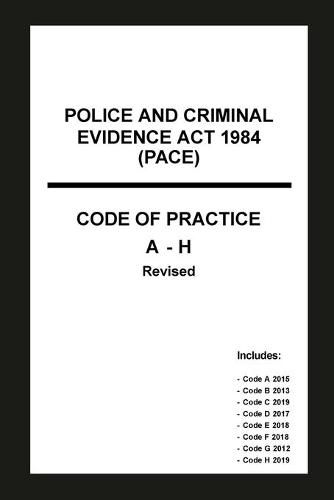Readings Newsletter
Become a Readings Member to make your shopping experience even easier.
Sign in or sign up for free!
You’re not far away from qualifying for FREE standard shipping within Australia
You’ve qualified for FREE standard shipping within Australia
The cart is loading…






This title is printed to order. This book may have been self-published. If so, we cannot guarantee the quality of the content. In the main most books will have gone through the editing process however some may not. We therefore suggest that you be aware of this before ordering this book. If in doubt check either the author or publisher’s details as we are unable to accept any returns unless they are faulty. Please contact us if you have any questions.
The Police and Criminal Evidence Act 1984 codes of practice regulate police powers and protect public rights. Last update 18 June 2020. PACE Codes of Practice sets out to strike the right balance between the powers of the police and the rights and freedoms of the public. Maintaining that balance is a central element of PACE. The PACE codes of practice cover: - Stop and search - Arrest - Detention - Investigation - Identification - Interviewing detainees Content in this book: Code A 2015: Exercise by police officers of statutory powers to search a person or a vehicle without first making an arrest and the need for a police officer to make a record of a stop or encounter. Code B 2013: Police powers to search premises and to seize and retain property found on premises and persons. Code C 2019: Requirements for the detention, treatment and questioning of suspects not related to terrorism in police custody by police officers. Includes the requirement to explain a person’s rights while detained and the requirement to explain the rights of a person who has not been arrested that apply to a voluntary interview. Code D 2017: Main methods used by the police to identify people in connection with the investigation of offences and the keeping of accurate and reliable criminal records. Code E 2018: Audio recording of interviews with suspects in the police station. Code F 2018: Visual recording with sound of interviews with suspects - there is no statutory requirement on police officers to visually record interviews, but the contents of this code should be considered if an interviewing officer decides to make a visual recording with sound of an interview with a suspect. Code G 2012: Powers of arrest under section 24 the Police and Criminal Evidence Act 1984 as amended by section 110 of the Serious Organised Crime and Police Act 2005. Code H 2019: requirements for the detention, treatment and questioning of suspects related to terrorism in police custody by police officers. Includes the requirement to explain a person’s rights while detained in connection with terrorism. - Section 60 and 66 of Police and Criminal Evidence Act 1984 not includes in this version. - This version includes blank pages for notes taking.
$9.00 standard shipping within Australia
FREE standard shipping within Australia for orders over $100.00
Express & International shipping calculated at checkout
This title is printed to order. This book may have been self-published. If so, we cannot guarantee the quality of the content. In the main most books will have gone through the editing process however some may not. We therefore suggest that you be aware of this before ordering this book. If in doubt check either the author or publisher’s details as we are unable to accept any returns unless they are faulty. Please contact us if you have any questions.
The Police and Criminal Evidence Act 1984 codes of practice regulate police powers and protect public rights. Last update 18 June 2020. PACE Codes of Practice sets out to strike the right balance between the powers of the police and the rights and freedoms of the public. Maintaining that balance is a central element of PACE. The PACE codes of practice cover: - Stop and search - Arrest - Detention - Investigation - Identification - Interviewing detainees Content in this book: Code A 2015: Exercise by police officers of statutory powers to search a person or a vehicle without first making an arrest and the need for a police officer to make a record of a stop or encounter. Code B 2013: Police powers to search premises and to seize and retain property found on premises and persons. Code C 2019: Requirements for the detention, treatment and questioning of suspects not related to terrorism in police custody by police officers. Includes the requirement to explain a person’s rights while detained and the requirement to explain the rights of a person who has not been arrested that apply to a voluntary interview. Code D 2017: Main methods used by the police to identify people in connection with the investigation of offences and the keeping of accurate and reliable criminal records. Code E 2018: Audio recording of interviews with suspects in the police station. Code F 2018: Visual recording with sound of interviews with suspects - there is no statutory requirement on police officers to visually record interviews, but the contents of this code should be considered if an interviewing officer decides to make a visual recording with sound of an interview with a suspect. Code G 2012: Powers of arrest under section 24 the Police and Criminal Evidence Act 1984 as amended by section 110 of the Serious Organised Crime and Police Act 2005. Code H 2019: requirements for the detention, treatment and questioning of suspects related to terrorism in police custody by police officers. Includes the requirement to explain a person’s rights while detained in connection with terrorism. - Section 60 and 66 of Police and Criminal Evidence Act 1984 not includes in this version. - This version includes blank pages for notes taking.